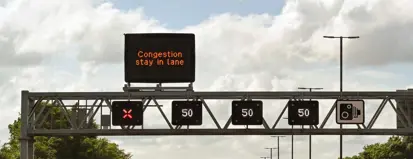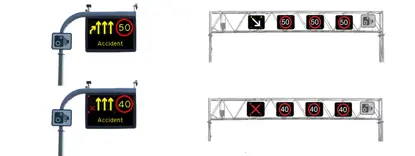What's a smart motorway?
A smart motorway's a section of the motorway that uses additional functions to manage the traffic and reduce congestion so that it can carry more vehicles without restricting the traffic flow.
You'll have seen the work being carried out to transform existing motorways sections into smart motorways and areas such as the M6 junctions 16 to 19 where they're now up and running.
The traffic management methods they utilise are using the hard shoulder as an additional lane, variable speed limits, and close monitoring of closed circuit television (CCTV) systems to ensure these measures are used in a safe manner.
How do smart motorways work?
Currently there are 3 different types of smart motorways running in the UK, which are:
- Controlled motorways
- Dynamic hard shoulder running schemes
- All lane running schemes
Each of them work a little differently so we've broken down the operation of them below.
Controlled motorways
Smart motorways that operate a controlled motorway scheme will have 3 or more lanes of traffic and an additional lane that remains a traditional hard shoulder. Over the lanes of running traffic there'll be a variable speed limit that may be applied.
Where the speed limit isn't displayed on overhead gantry signs it'll remain at the national speed limit of 70 mph.
Speed limits will be clearly displayed to drivers on the overhead signs at regular intervals, and this can change as you're driving so you should always make sure you're keeping to the speed displayed on the sign you most recently drove past.
The road covered by a variable limit will have speed cameras to enforce the limit at the time, and if caught exceeding this then you can receive a speeding fine. Highways England has advised that there'll be a small lag between the limit being implemented and the camera enforcing this limit to accommodate drivers sensibly reducing their speed, though they haven't advised how long this'll be so we'd recommend reducing your speed as quickly as possible whilst remaining safe on the road.
There'll also be cameras that are used to monitor the traffic flow on the road and implement the variable speed limit to reduce congestion or slow the impact of additional traffic to a high congestion area.
Dynamic hard shoulder running schemes
On a motorway that operates a dynamic hard shoulder, it means that generally the hard shoulder will remain an area for emergency refuge but when that stretch of road's particularly congested then it'll operate as an additional lane for traffic provided there's nobody using the hard shoulder for emergency reasons.
For this type of smart motorway the hard shoulder will still be marked by a solid white line to separate it from the regular lanes of traffic and it'll be the overhead signs which indicate whether you're able to drive in it.
If there's a red X or there's no sign above the lane then it shouldn't be used. In some areas there may be additional messages on larger roadside signs that say “hard shoulder for emergency use only”.
There'll also be variable speed limits on these motorways. Again, these limits will be shown on overhead signs and will be changed depending on the traffic congestion ahead. There'll be speed cameras monitoring the road as well and capturing anyone speeding above the variable speed limit.
All lane running schemes
An all lane running scheme converts the hard shoulder into a running lane permanently to provide an additional lane for traffic and reduce congestion.
Where an incident occurs, the lane will be closed to traffic, and marked so by an overhead sign, just like with a dynamic hard shoulder scheme. This'll still be classed as a dynamic hard shoulder.
There are emergency refuge areas spaced regularly along the carriageway for drivers and passengers of a broken down vehicle to use, provided they can safely reach them. There's concern that these aren't as close as possible and the distance was reduced from 1.5 miles to 1 mile in designs created since 2020.
CCTV will be used to monitor these roads for any vehicle in distress.
Just as with the other smart motorways operations, there'll also be a variable speed limit on an all lane running scheme as well and speed cameras used to enforce this.
What do smart motorway signals mean?
We’ve already mentioned a few times the overhead gantry signs which'll display your variable speed limits.
However, these signs can also show whether a lane's operational or not. If you look at the image below as well as the variable speed limit you'll see that the lane to the far left has a red cross above it.

This lane mustn't be used, and you should safely move into the next lane of traffic as soon as possible. A lot of the time a lane will be closed due to a vehicle in distress or debris on the road and so by remaining in that lane you could cause further accidents and harm to others and yourself.
If you don't leave the lane promptly then you'll be automatically fined £100 and receive 3 penalty points on your licence for ignoring the directive.
You might also see a sign with a white arrow directing you to move into a different lane. You should follow this as soon as you're able to as it'll usually precede a lane closure.
There may also be additional signs on the side of the road with the same instructions. We’ve included examples below.

Xcite Car Leasing top tips for smart motorway driving
1. Never drive in a lane closed by a red X
2. Stick to the speed limit shown overhead
3. Don’t speed up until you've passed the gantry showing the new speed limit
4. Don’t cross over a solid white line into the hard shoulder unless signs direct you to
5. If you break down, get to an emergency refuge area if it's safe for you to do so and call for help
